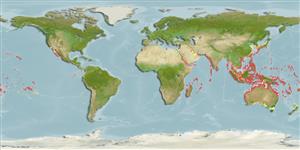Common names from other countries
Environment: milieu / climate zone / depth range / distribution range
Ekologi
; kisaran kedalaman 10 - 30 m (Ref. 337). Tropical
Indo-Pacific.
Length at first maturity / Size / Weight / umur
Maturity: Lm ? range ? - ? cm Max length : 8.0 cm SHL jantan/; (Ref. 349); common length : 6.5 cm SHL jantan/; (Ref. 349)
Collected by coastal populations in the tropical West Pacific for food and shell trade (Ref. 349). Often very common (Ref. 349). Found at depths of 10 to 30 m, on alga-covered rock (Ref. 337), and on coral reef flats on coral atolls and in tide pools on thin alga-sand bottom (Ref. 87884).
Life cycle and mating behavior
Kematangan | Reproduksi, perkembang biakan | Pemijahan | telur-telur | Fecundity | Larva
Members of the order Neotaenioglossa are mostly gonochoric and broadcast spawners. Life cycle: Embryos develop into planktonic trocophore larvae and later into juvenile veligers before becoming fully grown adults.
rujukan utama
Acuan | Koordinator | mitra
Poutiers, J.M. 1998. (Ref. 349)
Status IUCN Red List (Ref. 130435)
status CITES (Ref. 108899)
Not Evaluated
Not Evaluated
ancaman kepada manusia
Harmless
penggunaan manusia
Perikanan: komersial
| FishSource |
Alat, peralatan
informasi lanjut
Umur / SaizPertumbuhanpanjang-beratpanjang-panjangMorfologiLarvaKelimpahan
Sumber internet
Estimates based on models
Preferred temperature
(Ref.
115969): 23.8 - 29, mean 27.8 (based on 432 cells).
keancaman
Low vulnerability (10 of 100).
kategori harga
Unknown.
